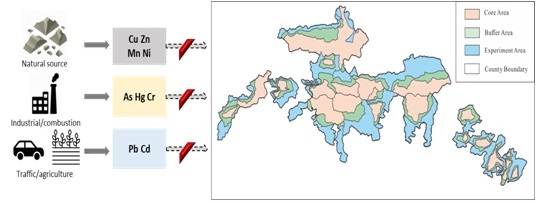The giant panda (Ailuropoda melanoleuca) is one of the most endangered animals in the world and is recognized worldwide as a symbol for conservation. The Qinling subspecies of giant panda (Ailuropoda melanoleuca qinlingensis) is highly endangered; fewer than 350 individuals still inhabit the Qinling Mountains. In order to better protect the giant panda, China announced the establishment of the first Giant Panda National Park (GPNP) in 2017, with a goal of restoring and connecting fragmented habitats.
A research led by Prof. CHEN Yiping from the Institute of Earth Environment (IEE) of the Chinese Academy of Sciences indicated that the proposal of GPNP shold take the environmental pollution caused by economic development in panda habitats into consideration.
This is a practical problem to be solved in the establishment of an environmentally sustainable giant panda national park in the Qinling area. These results was published in Science of the Total Environment.
In this study, the spatial distribution of heavy metals (Cd, Pb, Hg, Cu, Zn, Mn, Cr, Ni and As) was analyzed in giant panda feces, soil, bamboo, and water in four of GPNP's functional areas(core area, buffer area, experimental area and anthropogenically-dominated area) at different altitudes and latitudes.
The results showed that heavy metal pollution decreased with anthropogenic influences, from outside the reserve through the buffer and into the core area. Cu, Mn, Ni and Zn accumulated from natural sources; As, Hg and Cr were associated with fuel combustion; and Pb and Cd were associated with traffic and agriculture sources.
The presence of heavy metals at high altitudes and latitudes in the proposed GPNP was due to emissions from Xi'an and other upwind industrial cities. In the long run, it may threaten the food safety and health of giant pandas.
"Reducing emissions and heavy metal input should be considered in the design of the GPNP. Policy interventions should consider functional zones planning, wind direction, reducing mining, and the abandonment of existing roads and farmland within the GPNP to reduce other direct human impacts on the Qinling panda", said Prof. CHEN.

Fig.1 Reducing pollutants input to establish an environmentally sustainable Giant Panda National Park in the Qinling Mountains.(Image by ZHAO, et al)

Fig.2 Giant panda (Image by ZHAO, et al)
Contact: Bai Jie, Institute of Earth Environment, Chinese Academy of Sciences, Xi'an, China. Email: baijie@ieecas.cn
 © 2015 Institute of Earth Environment,CAS
© 2015 Institute of Earth Environment,CAS Address:No. 97 Yanxiang Road, Xi'an 710061, Shaanxi, China

 Location :
Location :